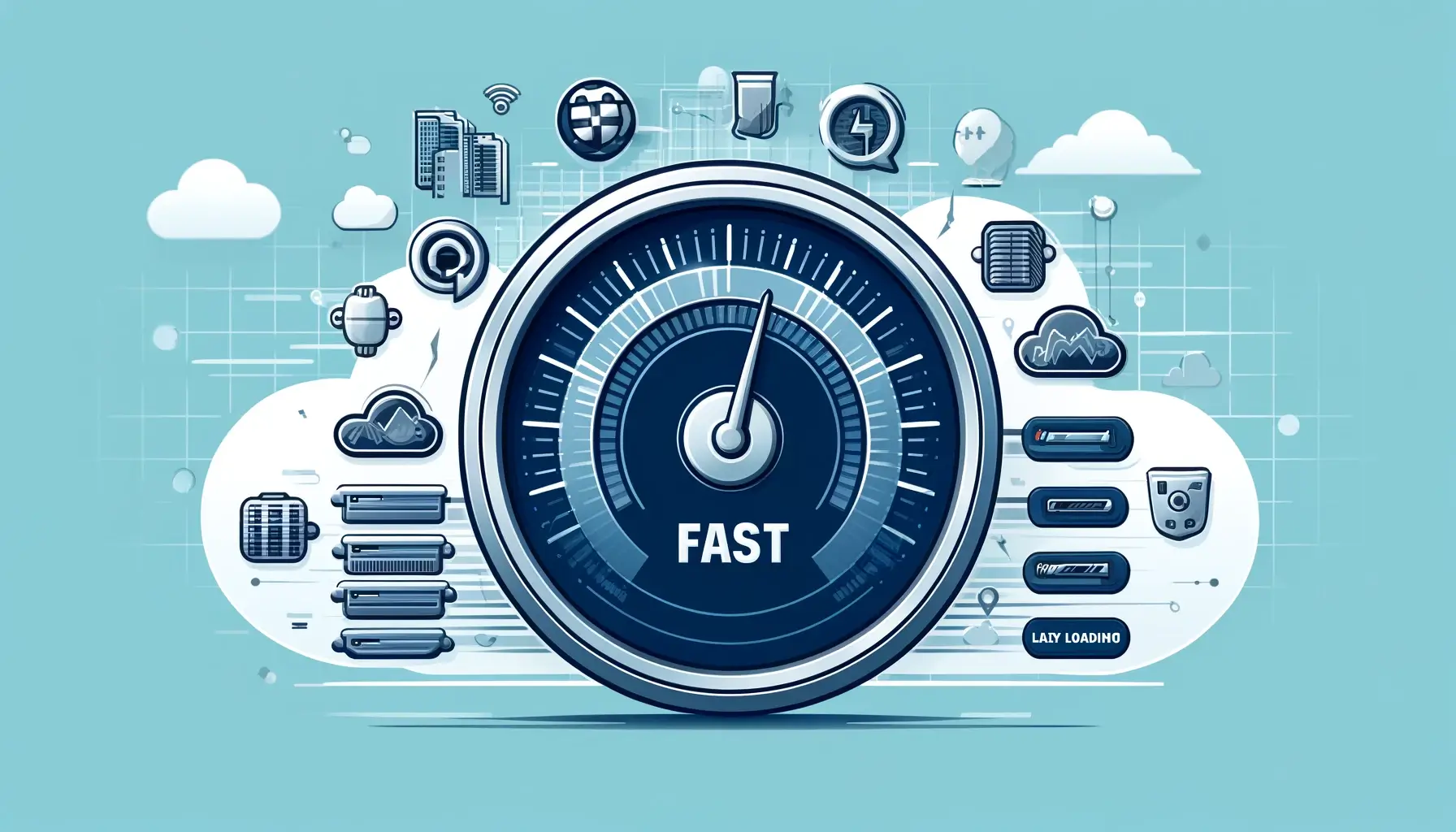How to Reduce Bounce Rate by Improving Website Speed

In the fast-paced digital world, website speed is no longer a mere convenience; it's a critical factor that directly impacts user experience and, consequently, your website's bounce rate. A slow-loading website can frustrate visitors, leading them to abandon your page before engaging with your content. This article explores the profound connection between website speed and bounce rate, providing actionable strategies to enhance performance and retain your audience.
Understanding the Bounce Rate and Its Significance
The bounce rate refers to the percentage of visitors who leave your website after viewing only one page. A high bounce rate signals that your website isn't effectively engaging visitors, which can negatively affect your search engine rankings and conversion rates. Website speed is a significant contributor to this problem. Users expect websites to load quickly, and even a few seconds of delay can lead to a significant increase in bounce rates.
The Direct Impact of Website Speed on Bounce Rate
Studies have shown a direct correlation between website loading time and bounce rate. For instance:
- A delay of just one second in page load time can result in a 7% reduction in conversions.
- As page load time increases from one second to three seconds, the probability of a bounce increases by 32%.
- If a page takes six seconds to load, the bounce rate can climb to a staggering 106%.
These statistics highlight the critical importance of optimizing website speed. A slow website not only deters visitors but also negatively impacts your SEO, as search engines like Google consider page speed as a ranking factor.
Strategies to Improve Website Speed
Improving website speed requires a multifaceted approach, addressing various aspects of your website's performance. Here are key strategies to consider:
1. Optimize Images
Images are often the largest files on a webpage. Optimizing them is crucial. Here's a deeper look:
- Compression: Use lossless or lossy compression. Lossless compression reduces file size without losing quality, while lossy compression sacrifices some quality for a smaller file size. Tools like TinyPNG (for PNG and JPEG) and Squoosh (web-based) allow you to compare compression levels.
- Format Selection: WebP offers superior compression and quality compared to JPEG and PNG. Use it when possible. Consider using the <picture> element to provide fallback formats for browsers that don't support WebP.
- Resizing: Don't upload unnecessarily large images. Resize them to the exact dimensions they'll be displayed on your webpage. Use responsive images with the
srcsetattribute to serve different image sizes based on the user's screen size. - Lazy Loading: Implement lazy loading for images below the fold. This delays loading until the user scrolls them into view, improving initial page load time.
2. Leverage Browser Caching
Browser caching stores static resources locally, reducing server load and speeding up subsequent visits:
- HTTP Headers: Use
Cache-ControlandExpiresheaders to control caching behavior.Cache-Controlprovides more flexibility, allowing you to specify cache duration and other directives. - ETag and Last-Modified: These headers help browsers determine if a resource has changed since the last visit. If not, the browser can use the cached version.
- Content Hash Filenames: Append a content hash to filenames (e.g., style.abc123def.css). This ensures that browsers download new versions of files when they change.
- Service Workers: For advanced caching, consider using service workers. They allow you to control caching behavior more granularly and even enable offline access.
3. Minify CSS, JavaScript, and HTML
Minification reduces file sizes by removing unnecessary characters:
- CSS: Remove whitespace, comments, and unnecessary semicolons. Tools like CSSNano and PurgeCSS can help.
- JavaScript: Use UglifyJS or Terser to minify JavaScript code. These tools also perform code optimization, reducing file size further.
- HTML: Remove whitespace and comments from your HTML code. Tools like HTMLMinifier can automate this process.
- Build Tools: Use build tools like Webpack or Gulp to automate minification during your development workflow.
4. Use a Content Delivery Network (CDN)
CDNs distribute your website's content across a network of servers:
- Proximity: CDNs serve content from the server closest to the user, reducing latency.
- Caching: CDNs cache static assets, reducing the load on your origin server.
- Global Reach: CDNs provide a global network, ensuring fast loading times for users worldwide.
- Security: Many CDNs offer security features like DDoS protection and SSL/TLS encryption.
5. Choose a Reliable Hosting Provider
Your hosting provider's infrastructure significantly impacts website speed:
- Server Location: Choose a hosting provider with servers located close to your target audience.
- Server Resources: Ensure your hosting plan provides sufficient CPU, RAM, and bandwidth for your website's needs.
- Server Type: Consider VPS or dedicated servers for better performance and control. Shared hosting can be sufficient for smaller websites.
- Uptime and Support: Choose a provider with a high uptime guarantee and responsive customer support.
6. Enable Gzip Compression
Gzip compression reduces file sizes before they are sent to the browser:
- Server Configuration: Enable Gzip compression in your server's configuration file (e.g., .htaccess for Apache, nginx.conf for Nginx).
- File Types: Compress text-based files like HTML, CSS, and JavaScript. Avoid compressing already compressed files like images and videos.
- Compression Level: Experiment with different compression levels to find the optimal balance between file size and compression time.
7. Reduce HTTP Requests
Each HTTP request adds to loading time:
- Combine Files: Combine multiple CSS and JavaScript files into fewer files.
- CSS Sprites: Combine multiple small images into a single image sprite and use CSS background positioning to display individual images.
- Inline Critical CSS: Inline the CSS needed for above-the-fold content to avoid render-blocking requests.
- Reduce External Scripts: Minimize the number of external scripts and libraries used on your website.
8. Optimize Database Performance
For dynamic websites, database optimization is crucial:
- Optimize Queries: Use indexes to speed up database queries. Avoid using
SELECT *and retrieve only the necessary data. - Database Caching: Use caching techniques like object caching and query caching to reduce database load.
- Regular Maintenance: Regularly clean up unnecessary data and optimize database tables.
- Database Server: Choose a fast and reliable database server (e.g., MySQL, PostgreSQL, MariaDB).
9. Implement Lazy Loading
Lazy loading improves initial page load time by deferring the loading of non-critical resources:
- Images and Videos: Use the
loading="lazy"attribute for images and iframes. - JavaScript Libraries: Lazy load JavaScript libraries that are not needed immediately.
- Intersection Observer API: Use the Intersection Observer API for more advanced lazy loading techniques.
10. Regularly Monitor and Test Website Speed
Regular monitoring helps identify performance bottlenecks and ensures that your optimizations are effective:
- Google PageSpeed Insights: Provides performance scores and recommendations for both mobile and desktop. It highlights specific areas for improvement, such as server response times, render-blocking resources, and image optimization.
- GTmetrix: Offers detailed performance reports, including waterfall charts, PageSpeed/YSlow scores, and video playback of page load. It helps visualize how different elements load and identify bottlenecks.
- WebPageTest: Provides detailed performance analysis from different locations and browsers, simulating real-world user experiences. It offers granular insights into network latency, server response times, and rendering performance.
- Lighthouse: An open-source, automated tool for improving the quality of web pages. It has audits for performance, accessibility, progressive web apps, SEO, and more. It can be run as a Chrome DevTools extension, from the command line, or as a Node module.
- Real User Monitoring (RUM): Collects performance data from actual users, providing insights into real-world performance. RUM tools like Google Analytics, New Relic, and Datadog capture metrics like page load times, response times, and error rates, allowing you to identify performance issues that affect real users.
- Synthetic Monitoring: Uses automated scripts to simulate user interactions and measure website performance from different locations and at different times. Tools like Pingdom and UptimeRobot provide synthetic monitoring, allowing you to proactively identify performance issues before they impact real users.
- Regular Audits: Schedule regular performance audits to track progress and identify new areas for improvement. Use the tools mentioned above to generate reports and analyze trends over time.
Conclusion
Reducing bounce rate by improving website speed is an ongoing and essential practice for any website owner. In today's digital landscape, where users expect instant gratification, a slow-loading website can quickly lead to frustration and abandonment. By implementing the strategies outlined in this article, you can significantly enhance your website's performance, improve user experience, and ultimately, reduce your bounce rate. Remember that website speed optimization is not a one-time task but a continuous process that requires regular monitoring and adjustments. Prioritize optimizing images, leveraging browser caching, minifying code, using a CDN, choosing a reliable hosting provider, enabling Gzip compression, reducing HTTP requests, optimizing database performance, implementing lazy loading, and regularly monitoring website speed. Each of these strategies contributes to a faster, more user-friendly website. By focusing on these key areas, you can ensure that your website not only attracts visitors but also keeps them engaged, leading to higher conversion rates and improved SEO rankings. A fast, efficient website is a cornerstone of online success, and investing in website speed optimization is an investment in your website's future.
Related WebCare Solutions
How to Troubleshoot a "403 Forbidden"
Learn why a 403 Forbidden error occurs, how it impacts site access, and simple steps to resolve it quickly.
How to Fix Infinite Redirect Loops and Too Many Redirects Errors
Learn how to diagnose and fix infinite redirect loops and "Too Many Redirects" errors in websites, including WordPress, .htaccess, Nginx, and Cloudflare.
Understanding Core Web Vitals and How They Impact Your SEO
A detailed guide to understanding Core Web Vitals and their impact on SEO. Learn how to measure and improve LCP, FID, and CLS for better search rankings.
Ready to get started?
Focus on your business while we fix your website. Contact WebCareSG today for fast, reliable solutions!
Whatsapp us on


